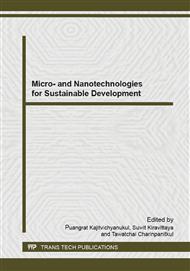[1]
A. Martí, N. López, E. Antolín, E. Cánovas, C. Stanley, C. Famer, L. Cuadra, and A. Luque, Novel semiconductor solar cell structures: the quantum dot intermediate band solar cell, Thin Solid Films 511-512 (2006) 638-644.
DOI: 10.1016/j.tsf.2005.12.122
Google Scholar
[2]
A. Luque, and A. Martí, Increasing the efficiency of ideal solar cells by photon induced transitions at intermediate levels, Physical Review Letters 78 (1997) 5014-5017.
DOI: 10.1103/physrevlett.78.5014
Google Scholar
[3]
K. Laouthaiwattana, O. Tangmattajittakul, S. Suraprapapich, S. Thainoi, P. Changmuang, S. Kanjanachuchai, S. Ratanathamaphan, and S. Panyakeow, Optimization of stacking high-density quantum dot molecules for photovoltaic effect, Solar Energy Materials & Solar Cells 93 (2009).
DOI: 10.1016/j.solmat.2008.09.020
Google Scholar
[4]
R. Songmuang, S. Kiravittaya, M. Sawadsaringkarn, S. Panyakeow, and O.G. Schmidt, Photoluminescence investigation of low-temperature capped self-assembled InAs/GaAs quantum dots, Journal of Crystal Growth 251 (2003) 166-171.
DOI: 10.1016/s0022-0248(02)02474-0
Google Scholar
[5]
J. Phillips, K. Kamath, and P. Bhattacharya, Far-infrared photoconductivity in self-organized InAs quantum dots, Applied Physics Letters 72 (1998) 2020-(2022).
DOI: 10.1063/1.121252
Google Scholar
[6]
Y. Osaka, H. Tanabe, K. Yamada, and K. Yamaguchi, Wideband luminescence of high-density InAs quantum dots on GaAsSb/GaAs layers, Journal of Crystal Growth 378 (2013) 422-425.
DOI: 10.1016/j.jcrysgro.2012.12.042
Google Scholar
[7]
P. B. Joyce, T. J. Krzyzewski, G. R. Bell, T. S. Jones, S. Malik, D. Childs, and R. Murray, Effect of growth rate on the size, composition, and optical properties of InAs/GaAs quantum dots grown by molecular-beam epitaxy, Physical Review B 62 (2000).
DOI: 10.1103/physrevb.62.10891
Google Scholar
[8]
S. Ruangdet, S. Thainoi, S. Kanjanachuchai, and S. Panyakeow, Improvement of PV performance by using multi-stacked high density InAs quantum dot molecules, in: Proceedings of the 4th WCPEC, Hawaii, USA, (2006).
DOI: 10.1109/wcpec.2006.279430
Google Scholar
[9]
A. Hospodková, J. Pangrác, M. Zíková, J. Oswald, J. Vyskočil, P. Komninou, J. Kioseoglou, N. Florini, and E. Hulicius, Effect of the lower and upper interfaces on the quality of InAs/GaAs quantum dots, Applied Surface Science 301 (2014) 173-177.
DOI: 10.1016/j.apsusc.2014.02.033
Google Scholar
[10]
M. Berginc, U. O. Krašovec, M. Jankovec, and M. Topič, The effect of temperature on the performance of dye-sensitized solar cells based on a propyl-methyl-imidazolium iodide electrolyte, Solar Energy Materials & Solar Cells 91 (2007) 821–828.
DOI: 10.1016/j.solmat.2007.02.001
Google Scholar
[11]
P. Kumar, S. C. Jain, H. Kumar, S. Chand, and V. Kumar, Effect of illumination intensity and temperature on open circuit voltage in organic solar cells, Applied Physics Letters 94 (2009) 183505.
DOI: 10.1063/1.3129194
Google Scholar
[12]
G. Kumar, and A. K. Panchal, A non-iterative technique for determination of solar cell parameters from the light generated I-V characteristic, Journal of Applied Physics 114 (2013) 084904.
DOI: 10.1063/1.4819961
Google Scholar
[13]
E. E. van Dyk, and E. L. Meyer, Analysis of the effect of parasitic resistances on the performance of photovoltaic modules, Renewable Energy 29 (2004) 333-344.
DOI: 10.1016/s0960-1481(03)00250-7
Google Scholar
[14]
J. Lindmayer, and J. F. Allison, The violet cell: an improved silicon solar cell, COMSAT Technical Review 3 (1973) 1-22.
Google Scholar
[15]
A. D. Dhass, E. Natarajan, and L. Ponnusamy, Influence of shunt resistance on the performance of solar photovoltaic cell, in: Proceeding on the 2012 ICETEEM International Conference, Chennai, India, (2012).
DOI: 10.1109/iceteeem.2012.6494522
Google Scholar
[16]
J. Merten, J. M. Asensi, C. Voz, A. V. Shah, R. Platz, and J. Andreu, Improved Equivalent Circuit and Analytical Model for Amorphous Silicon Solar Cells and Modules, IEEE Transactions on Electron Devices 45 (1998) 423-429.
DOI: 10.1109/16.658676
Google Scholar
[17]
B. Triphathi, P. Yadav, and M. Kumar, Effect of varying illumination and temperature on steady-state and dynamic parameters of dye-sensitized solar cell using AC impedance modeling, International Journal of Photoenergy 2013 (2013).
DOI: 10.1155/2013/646407
Google Scholar
[18]
A. Ortiz-Conde, F. J. Garcia Sanchez, and J. Muci, New method to extract the model parameters of solar cells from the explicit analytic solutions of their illuminated I-V characteristics, Solar Energy Materials & Solar Cells 90 (2006) 352-361.
DOI: 10.1016/j.solmat.2005.04.023
Google Scholar
[19]
Y. Chen, X. Wang, D. Li, R. Hong, and H. Shen, Parameter extraction from commercial solar cells I-V characteristics and shunt analysis, Applied Energy 88 (2011) 2239-2244.
DOI: 10.1016/j.apenergy.2010.12.048
Google Scholar
[20]
MathWorks, Optimization toolboxTM: R2014a user's guide, The MathWorks, Inc., 3 Apple Hill Drive Natrick, Massachusetts, USA, 2014. [Online].
Google Scholar
[21]
E. Radziemska, The Effect of temperature on the power drop in crystalline silicon solar cells, Renewable Energy 28 (2003) 1-12.
DOI: 10.1016/s0960-1481(02)00015-0
Google Scholar
[22]
R. Sharma, Temperature dependence of I-V characteristics of Au/n-Si Schottky Barrier Diode, Journal of Electron Devices 8 (2010) 286-292.
Google Scholar


